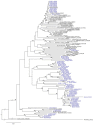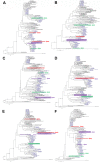Molecular characterization of type 1 porcine reproductive and respiratory syndrome viruses (PRRSV) isolated in the Netherlands from 2014 to 2016
- PMID: 31246977
- PMCID: PMC6597066
- DOI: 10.1371/journal.pone.0218481
Molecular characterization of type 1 porcine reproductive and respiratory syndrome viruses (PRRSV) isolated in the Netherlands from 2014 to 2016
Abstract
Porcine reproductive and respiratory syndrome virus (PRRSV) is the causative agent of a devastating pig disease present all over the world. The remarkable genetic variation of PRRSV, makes epidemiological and molecular analysis of circulating viruses highly important to review current diagnostic tools and vaccine efficacy. Monitoring PRRS viruses supports modern herd management by explaining the source of found viruses, either internally or externally from the herd. No epidemiological or molecular study has been published on circulating PRRS-viruses in the Netherlands, since the early nineties. Therefore, the objective of this study is to investigate circulating PRRS-viruses in the Netherlands in 2014, 2015 and 2016 on a molecular level by sequencing ORF2, ORF3, ORF4, ORF5, ORF6 and ORF7. The results demonstrate that the 74 PRRSV strains belong to PRRSV-1, but the diversity among strains is high, based on nucleotide identity, individual ORF length and phylogenetic trees of individual ORFs. Furthermore, the data presented here show that the phylogenetic topology of some viruses is ORF dependent and suggests recombination. The identity of the strain of interest might be misinterpreted and wrong conclusions may be drawn in a diagnostic and epidemiological perspective, when only ORF5 is analyzed, as performed in many routine sequencing procedures.
Conflict of interest statement
The authors of this manuscript have read the journal's policy and have the following competing interests: This work was supported by grants from Boehringer Ingelheim and MSD Animal Health. GD Animal Health provided support in the form of salaries of all authors and is owner of the samples analyzed in this study. These samples are not freely available. GD Animal Health did not have any additional role in the study design, data collection and analysis, decision to publish, or preparation of the manuscript. JCFMD and TFD won the European PRRS research award 2018 provided by Boehringer Ingelheim. There are no patents, products in development or marketed products associated with this research to declare. This does not alter the authors' adherence to PLOS ONE policies on sharing data and materials.
Figures



References
-
- Zimmerman JJ. Porcine reproductive and respiratory syndrome virus (porcine arterivirus). In: Zimmerman JJ, Karriker LA, Ramirez A, Schwartz KJ, Stevenson GW, editors. Diseases of Swine. 10 ed2010.
-
- Kvisgaard LK. Porcine Reproductive and Respiratory Syndrome Virus (PRRSV) [PhD]. Frederiksberg, Denmark: National Veterinary Institute, Technical University of Denmark; 2013. - PubMed
Publication types
MeSH terms
Substances
LinkOut - more resources
Full Text Sources
Other Literature Sources

